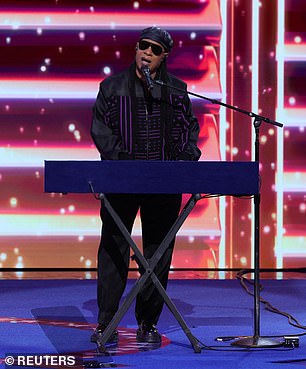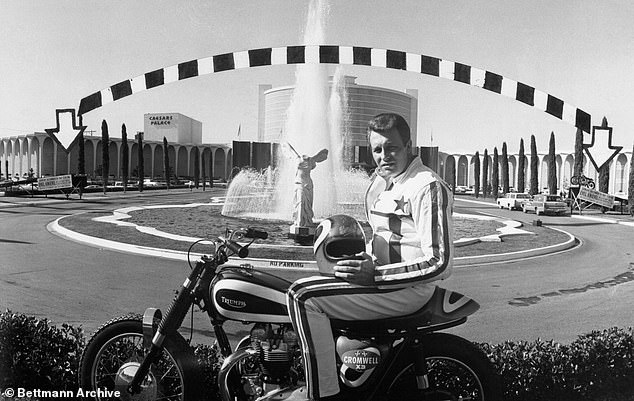As 100,000 Americans wait for organs every day, here are the celebrities who have received life-saving transplants








There are more than 103,000 people on the transplant list in the US, and more than a dozen die every day waiting for an organ.
Every eight minutes, another person is added.
An organ transplant is generally considered to be a last resort when other treatments have failed or when a person’s condition has deteriorated to the point where no other recourse is possible.
People may need a transplant for a multitude of reasons, including chronic and autoimmune conditions, heart disease, diabetes or cancer.
And while they may be lifesaving, transplants come with a hefty amount of risk, as the body can reject the organ once it’s placed in the patient, even with an arsenal of anti-rejection medications.
While risky, however, recipients say transplants have transformed their lives.
Here are some of our favorite stars’ stories of their organ transplants.
Selena Gomez

Selena Gomez has spoken publicly about her battle with lupus and resulting kidney transplant in 2017
Selena Gomez has made countless headlines throughout her career, including in 2017 when she underwent a kidney transplant at 25 after suffering complications from lupus, an autoimmune disease that causes the body to attack its own healthy organs and tissues.
Lupus can cause kidney inflammation and damage when antibodies attack parts of the kidneys that filter waste. This leads to swelling and irritation, which prevents the organs from working properly.
Healthy kidneys produce urine, remove waste products from the blood, keep electrolytes in balance, and help develop red blood cells. But when the kidneys aren’t working properly, people can experience bloody urine, high blood pressure and eventually kidney failure.
Selena’s friend and fellow actor Francia Raisa volunteered to get tested to see if her kidney would be compatible with Selena.
And in 2017, Francia gave Selena the ‘ultimate gift and sacrifice’ after she had been battling lupus for five years.
The average wait time for a donated kidney is five years, but it can be longer for people with different medical conditions or those with a rare blood type.
Selena told Today’s Savannah Guthrie: ‘I didn’t want to ask a single person in my life. The thought of asking somebody to do that was really difficult for me.
‘Let alone somebody wanting to volunteer, it is incredibly difficult to find a match. The fact that she was a match, that was unbelievable.’
Since her ordeal, Selena said her blood pressure has normalized, her quality of life has improved, and she has continued to speak publicly about her battle.
Kidney transplants can be performed as ‘living donations’ because humans have two of these crucial organs – and if you’re healthy, you can live with only one, as long as it’s functioning properly.
In 2021, the latest data available, 25,550 kidney transplants were performed in the United States and 72,860 more people were on the waitlist for the organ.
Sarah Hyland

Sarah Hyland has had two kidney donations, both from family members
Sarah Hyland, an actor on the popular sitcom Modern Family, underwent two kidney transplants, first in 2012 and again in 2017.
Sarah was born with kidney dysplasia, a condition in which the kidneys do not develop properly in the womb, causing them to be malformed and less effective at filtering waste and making urine.
She received a donated kidney from her father in 2012 when she was 21 years old. But her body rejected it four years later and she was forced to go on dialysis three times a week.
Dialysis is a treatment for people with kidney conditions that removes waste and excess fluid from the body when the kidneys aren’t functioning properly.
She told Self Magazine she was deeply depressed at that time: ‘When a family member gives you a second chance at life, and it fails, it almost feels like it’s your fault. It’s not. But it does.’
Her brother gave her the gift of a healthy kidney in 2017.
While parents and children have a 50 percent chance of being a match for organ donation and siblings have a 25 percent match, a successful surgery is not guaranteed.
In fact, 70 percent of people who need a transplant don’t have a fully matched donor within their family – and even patients who do still have a chance of rejecting the transplanted organ.
Mandy Patinkin
The former Criminal Minds star received a corneal transplant in 1997 after suffering years of damage from keratoconus, a progressive condition that causes the usually round, dome-shaped cornea on the front surface of the eye to thin out and bulge into a cone-like shape.

Mandy Patinkin underwent a corneal transplant in 1997
It causes the tissue of the cornea to break down, stretch and scar over. This disrupts the cornea’s ability to focus light correctly and severely impairs a person’s vision.
While the condition can sometimes be corrected by wearing hard contacts, Mandy Patinkin – diagnosed in 1982 – said at the 1997 Tony Awards his eyes could no longer withstand them.
So his doctors recommended a corneal transplant for his right eye, a procedure in which the damaged cornea is replaced with corneal tissues from donors with healthy eyes.
The then 44-year-old received a cornea ‘thanks to the generosity of a family who donated their child’s corneas to the eye bank.’
Mandy added: ‘I was the lucky recipient of one of the child’s corneas. I will say a prayer for this child every day of my life for as long as I live.’
Corneal transplants are common and, most often, a highly successful means of restoring sight by replacing damaged tissue.
Approximately 45,000 corneal transplants are performed in the US every year, making it the second most common type of transplant after blood donations.
Tracy Morgan

Tracy Morgan’s kidney transplant is believed to be tied to his diabetes
SNL and 30 Rock alum Tracy Morgan underwent a kidney transplant in December 2010 when his ex-girlfriend donated one of her organs to the comedian.
The transplant is believed to be tied to his diabetes, which he was diagnosed with in 1996 but didn’t take seriously until he got severely sick and was facing a possible foot amputation.
The then 41-year-old told Time: ‘The doctor was like, “Hey, listen, we may have to take your foot.” That was it for me. Now I take my insulin every day. My blood sugar doesn’t get over 120.’
Mismanaged blood sugar levels over time in people with diabetes can inflict damage on blood vessels in the kidneys, leading to a condition known as diabetic nephropathy, the chronic loss of kidney function and, eventually, kidney disease and failure.
Several weeks after his transplant, he thanked a woman named Tanisha for donating her kidney, presumably referring to ex-girlfriend Tanisha Hall.
Tracy said earlier this year at an event encouraging living organ donation: ‘I am living proof of the benefits of organ donation, and it has given me an opportunity to show people that you can go on and live a full life when you find a match.
‘My donor saved my life and by enrolling in the New York Donate Life Registry, you could help save many others.’
Stevie Wonder
The legendary musician, 74, underwent a kidney transplant in 2019. The 25-time Grammy winner had been dealing with unspecified health issues in the lead up to the hush-hush surgery.
Stevie Wonder announced the transplant at a London concert in June 2019, where he told fans, ‘I have a donor and it’s all good’ and that he would be taking a break from performing.

Stevie Wonder’s kidney transplant stemmed from unspecified health issues
Details on why he needed a transplant have not been revealed and not much is known about his operation other than he received the organ from a living donor.
Patients could need kidney transplants for a number of reasons, including because of diabetes, high blood pressure and autoimmune diseases.
Stevie said during a virtual press conference in 2020 that he had been ‘blessed with a new kidney’ in December 2019.
He added: ‘Since I have been released from the hospital, the nurses have made sure I’ve taken my medicine on time and I’m going to do it for as long as I have to, even if it is the rest of my life.
‘I feel great. My voice feels great. I feel like I’m about 40 right now and I just thank everyone for the prayers and the love.
‘And for all of the people that have been listening to these rumors, listen, if I’m feeling some kind of way, I’ll let you know. We don’t want to have misinformation. I am alive and well.’
According to the National Kidney Foundation, someone is added to the kidney transplant list in the US every 14 minutes, with more than 3,000 new patients added each month.
Evel Knievel

Evel Knievel underwent a liver transplant in 1999 after years of suffering from hepatitis C
The famous motorcycle daredevil Evel Knievel – whose real name was Robert Craig Knievel – received a liver transplant in Tampa, Florida in 1999.
The Washington Post reported in January 1999 the stuntman, then 60, was recovering at Tampa General Hospital but the family did not release any information on the operation.
Evel Knievel had hepatitis C, which he believed he contracted from one of the numerous blood transfusions he received after he suffered injuries during crashes in the 1960s and 70s.
He said: ‘[Hepatitis] hits you hard, saps your strength, gives you a fever. I’ve had to spend up to a week at a time in bed because I have no energy at all. It’s just a killer.’
The hepatitis destroyed his liver, the Post reported at the time, and Evel Knievel had been hospitalized before the surgery with dehydration and remained there while awaiting his transplant.
Just three months later, he was hospitalized with dizziness and fatigue and told the Las Vegas Sun he feared he was rejecting his liver. At the time, he said doctors were attempting to find the cause.
Evel Knievel said: ‘I think my body is rejecting the liver or my hepatitis C is coming back and overtaking my liver. I’ve been feeling weak and dizzy and tired.’
No further update was given on the status of his condition or transplanted organ.
Hepatitis C is a viral bloodborne infection that causes inflammation of the liver. These patients account for 40 to 50 percent of people on the liver transplant waiting list and those who receive new organs.
The transplant doesn’t cure the condition and a second one may be needed if the disease damages the new organ.
In 2023, there were 10,660 liver transplants in the US – the most in any year and a 12 percent increase from the year prior.
Livers can be given from a deceased donor or a living donor. The liver has the ability to regenerate itself so doctors only need to transplant about half of the organ.
George Lopez
In April 2005, the comedian George Lopez underwent a kidney transplant, receiving a kidney from his then-wife, Ann Lopez.
The couple underwent simultaneous surgeries in nearby operating rooms at a Los Angeles-area hospital.
George, who was 44 at the time of his surgery, was born with an abnormality that caused the narrowing of his ureters, the tubes that carry urine from the kidneys to the bladder, and the organs never truly functioned properly.

George Lopez received a kidney from his then-wife after suffering years of pain from near-total kidney failure
Because his ureters were so narrow, his kidneys could not efficiently filter waste from his body, slowly ‘poisoning’ him and pushing the actor close to kidney failure, WebMD reported.
His situation deteriorated gradually until he went to the doctor in so much pain he could not stand up.
He learned his kidneys had begun shutting down. They were barely functioning and had shrunk so much they no longer could be seen on an ultrasound.
While a doctor said he needed surgery in April 2004, George continued to work until all the episodes of his hit sitcom had been filmed.
The following April, he underwent the transplant and it went so well he was back on the golf course 10 days later, he said.
George told WebMD his pain and fatigue subsided after his surgery and his stellar recovery from being in near-total kidney failure still surprises him.
However, George, like other organ recipients, will likely be on anti-rejection medications for the rest of his life, including ones that cause tremors – which may make golfing more challenging.
George said on his foundation’s website: ‘I am thankful for the kidney transplant I received in 2005, which has allowed me to pursue my two passions – playing golf and giving back to others less fortunate.’




